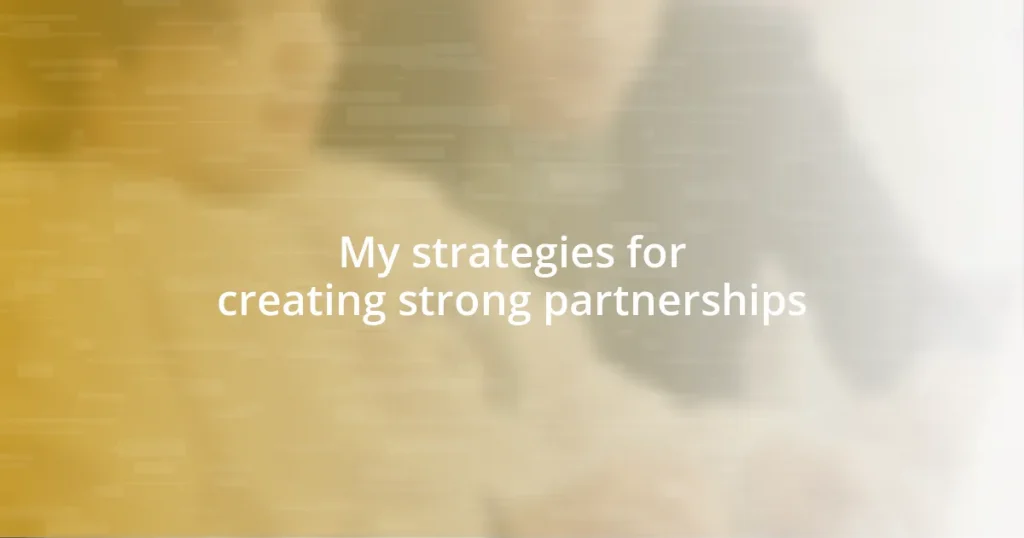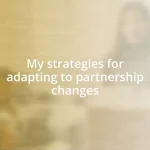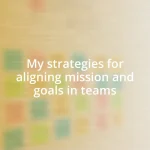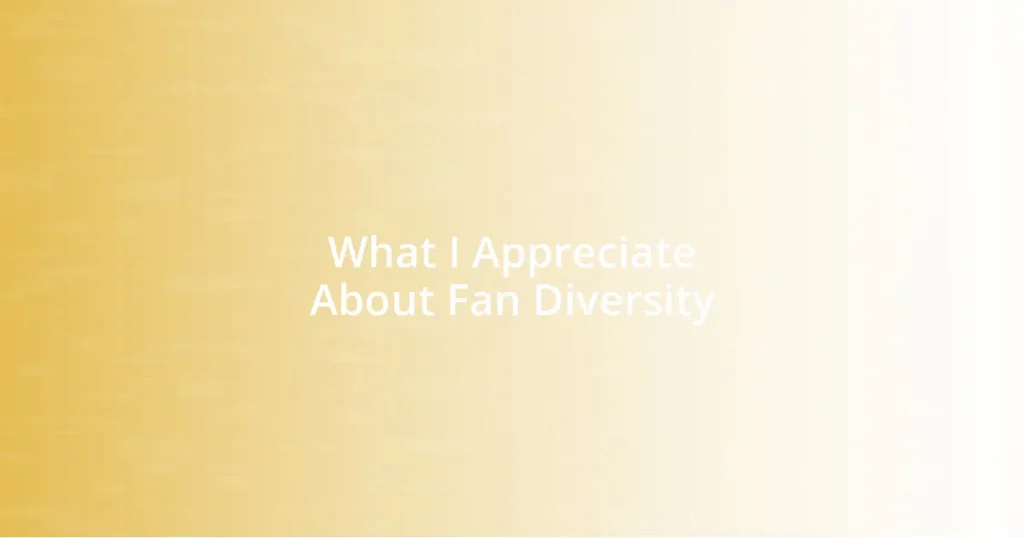Key takeaways:
- Effective communication, including open dialogue and active listening, is central to successful partnerships.
- Building trust and respect is essential; vulnerability and constructive feedback enhance connections.
- Establishing mutual goals from the outset reduces misunderstandings and fosters collaboration.
- Nurturing the partnership through regular check-ins, celebrating milestones, and allowing space for each other strengthens the bond.
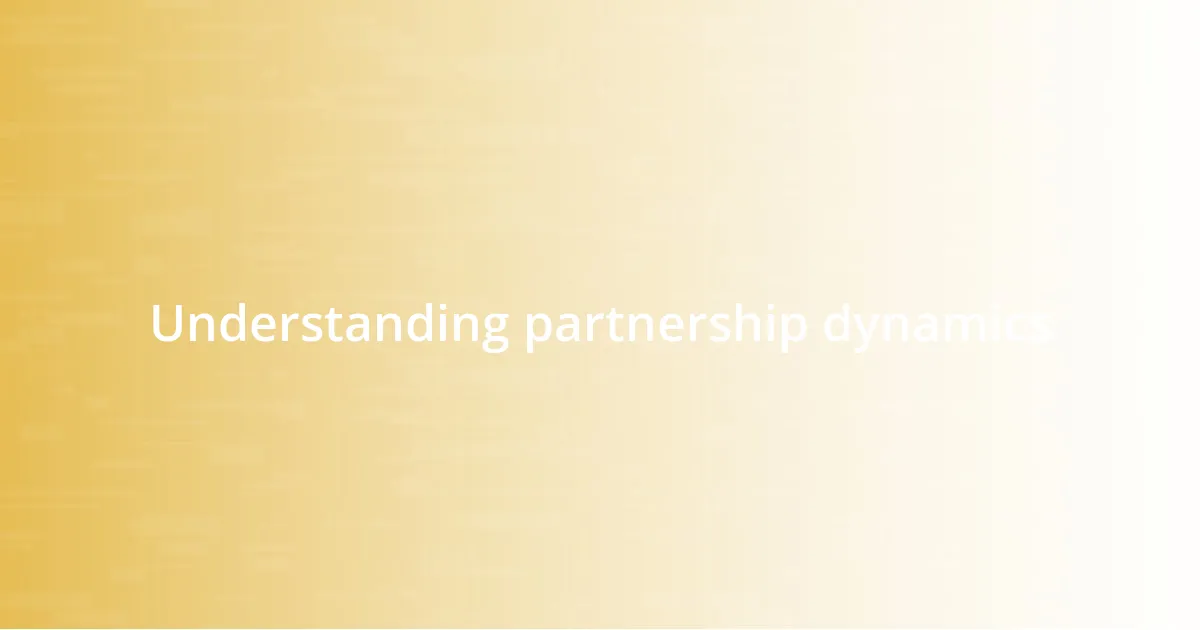
Understanding partnership dynamics
Partnership dynamics can be quite fascinating, often resembling a delicate dance. Each partner brings their own rhythm, which can either harmonize beautifully or lead to missteps. I remember collaborating with a colleague who had a very different approach to problem-solving; at first, our interaction felt more like a tug-of-war than a collaboration. However, once we started to understand each other’s styles, we found a rhythm that worked wonders for our project.
At the heart of strong partnerships lies effective communication. Have you ever noticed how misunderstandings can spiral out of control if not addressed early? In one of my recent partnerships, I experienced this firsthand. We both had assumptions that went unspoken, and it led to frustration. It was a pivotal moment when I realized the importance of checking in regularly to ensure we were aligned. This simple practice dramatically improved our collaboration.
Trust is another crucial element in the dynamics of partnerships. I’ve come to believe that without trust, no effective partnership can thrive. I once worked with someone I didn’t fully trust, which created a palpable tension that hindered our progress. Reflecting on that experience, I see now that building trust often takes time and requires vulnerability, but it’s truly worth the effort. Wouldn’t you agree that fostering transparency is key to deepening that bond?
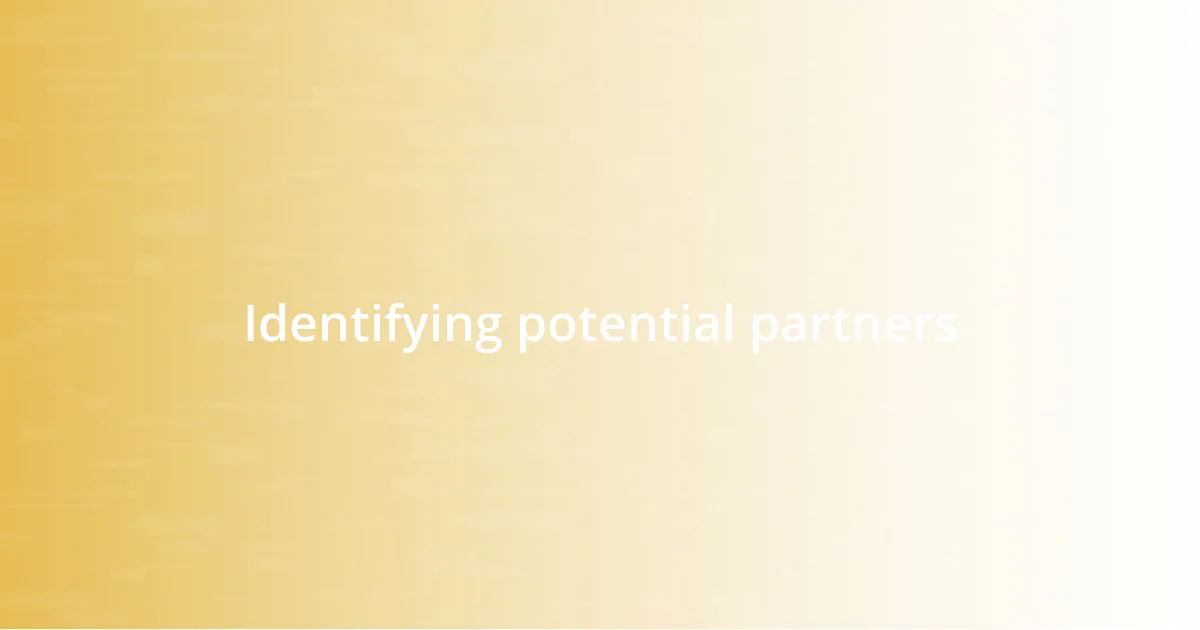
Identifying potential partners
Identifying potential partners can be a revealing process. I often think of this as a search for common goals and values. In one instance, I was working in a community project when I realized that aligning my objectives with those of potential partners led to stronger connections and mutual investment. It was a deliberate step, but it made all the difference in ensuring a fruitful collaboration.
Sometimes, potential partners can be found in the most unexpected places. While attending a local networking event, I struck up a conversation with someone who shared a passion for sustainable practices. It struck me how often we overlook individuals just because they don’t fit the usual mold of a partner. This encounter taught me that broadening my search criteria could lead to extraordinary partnerships.
When identifying potential partners, I also consider reputation and reliability. In a previous collaboration, I was drawn to a partner with a solid track record in delivering projects on time. Their credibility gave me comfort, and I felt more confident committing to our joint efforts. The lesson here is that a partner’s past can often signal future success—don’t underestimate the value of due diligence.
| Criteria | Personal Experience |
|---|---|
| Common Goals | Aligned objectives facilitated a smooth collaboration. |
| Unexpected Sources | Engaging with diverse individuals often leads to surprising partnerships. |
| Reputation | Reliable partners inspire confidence and enhance project success. |
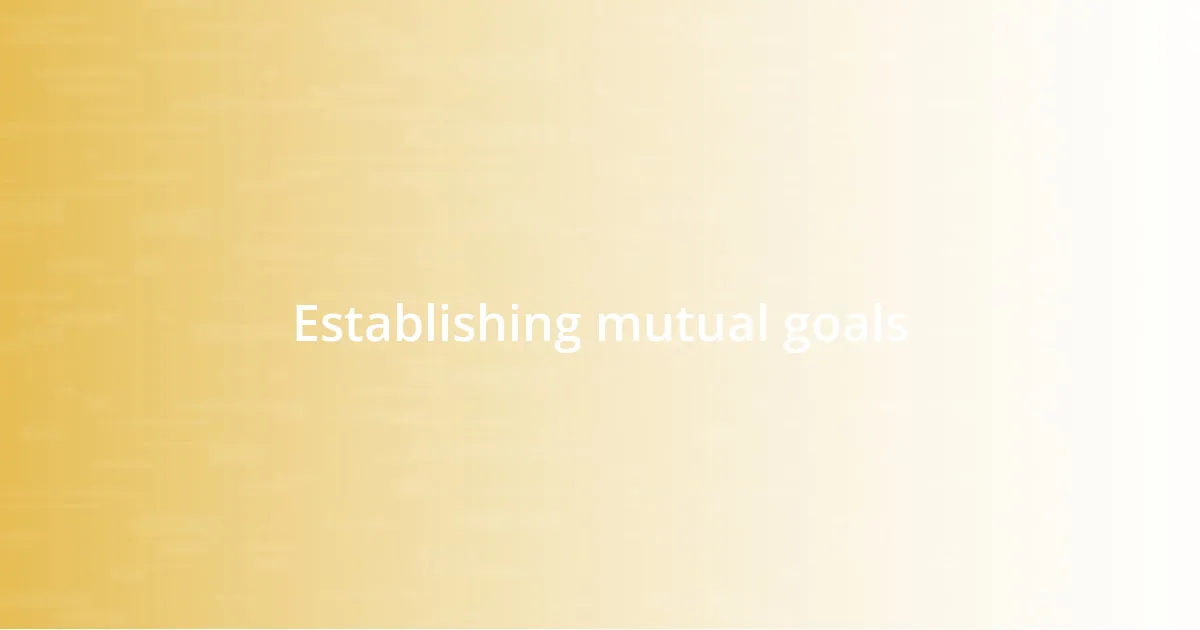
Establishing mutual goals
Establishing mutual goals is foundational in building strong partnerships. I recall working on a project where my partner and I sat down early on to map out our respective objectives. It felt almost like we were architects designing a shared blueprint. Collaboratively, we drafted our vision, ensuring that both our aspirations were integrated into the project’s framework. This moment of alignment drastically reduced misunderstandings later on.
When I think about the steps to create mutual goals, a few key actions come to mind:
- Open Dialogue: Initiate honest conversations to discuss what each partner hopes to achieve.
- Collaborative Brainstorming: Engage in brainstorming sessions where both perspectives are valued, fostering creativity and ownership.
- Measurable Objectives: Define clear, quantifiable goals that both partners can work towards, making progress easy to track.
The experience taught me that when both partners have a shared understanding of their goals, it’s like tuning an instrument before a performance—the harmony that follows is simply magical.
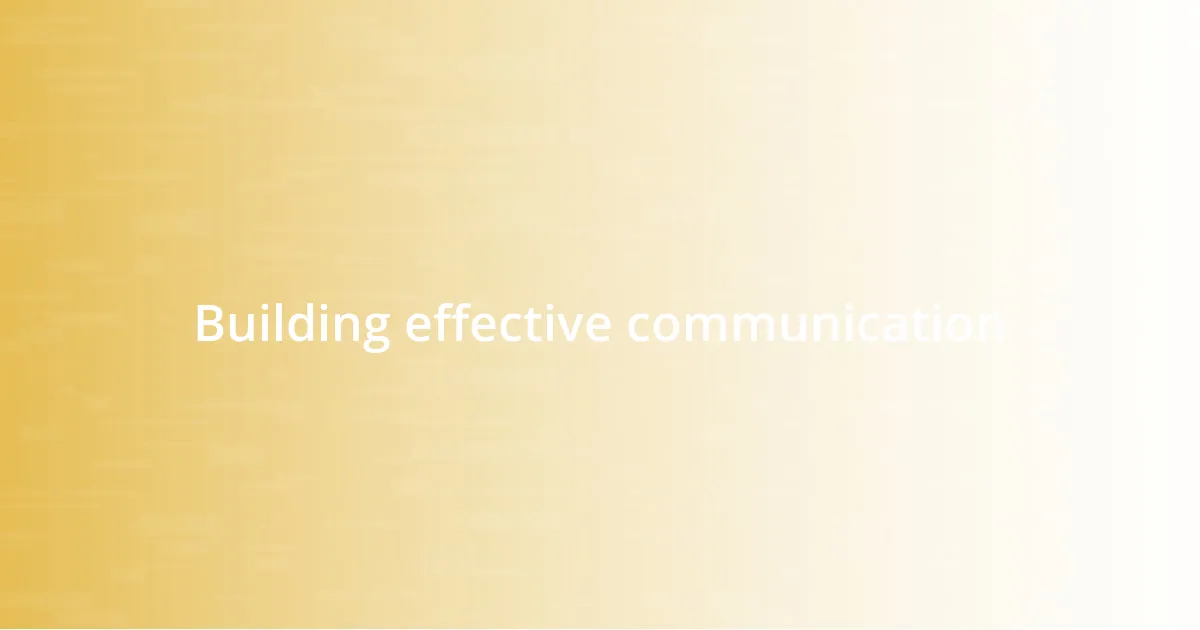
Building effective communication
Effective communication serves as the heartbeat of any partnership. I remember a time when I misread a partner’s email tone and assumed they were frustrated. It turned out that they were just concise in their messaging. That experience made me realize the importance of seeking clarification and confirming intentions. Have you ever assumed too much from a quick message? Taking the time to clarify can save so many future misunderstandings.
In my experience, active listening is crucial for building strong communication. When I engage with partners, I make a conscious effort to put my own thoughts aside and focus entirely on what they’re saying. I remember a meeting where I was so eager to share my ideas that I nearly missed a gem of an insight from my partner. That taught me that sometimes, the best ideas come from simply being present and open to another’s perspective.
Non-verbal cues play a significant role as well. I once attended a negotiation where my partner’s body language spoke volumes. They seemed hesitant at key moments, even though their words were positive. It taught me that paying attention to tone, eye contact, and posture can reveal deeper feelings and intentions. Are you tuned in to the silent messages people communicate? I’ve found that being perceptive in this way can greatly enhance the quality of our discussions and strengthen our connections.
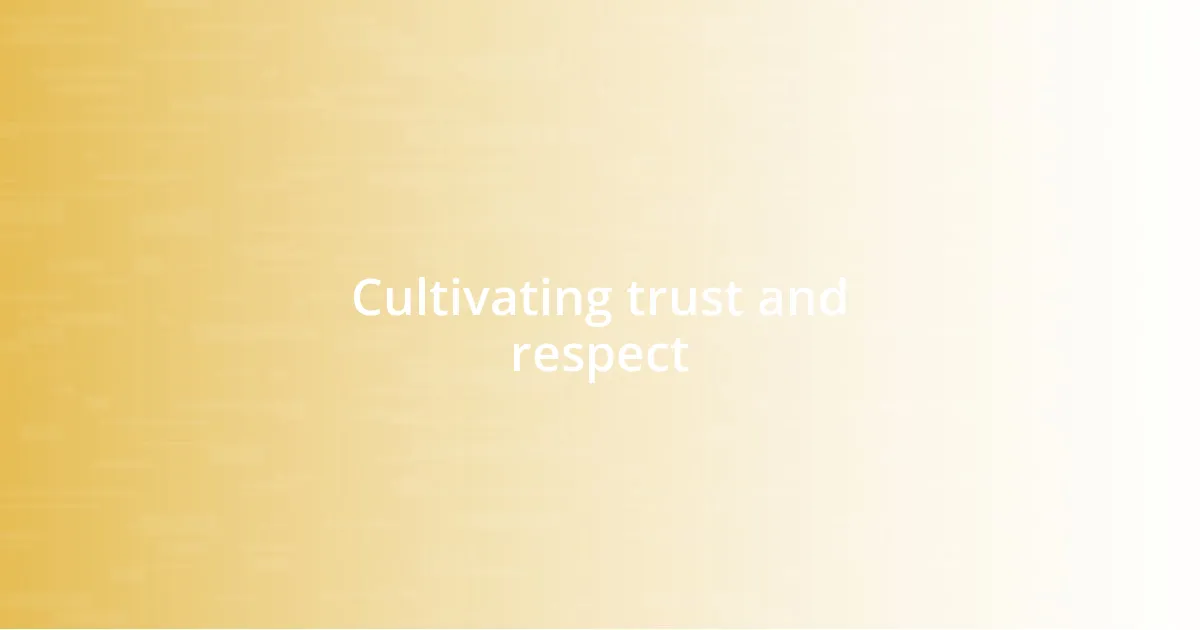
Cultivating trust and respect
Cultivating trust and respect is at the heart of successful partnerships. I had a colleague once who consistently delivered on his promises, no matter how small. After a few projects, I noticed that my respect for him grew immensely, simply because he showed that he valued our partnership. Have you ever recognized how a single action can resonate deeply? Trust builds slowly, like a garden; it requires consistent care and effort.
In my experience, showing vulnerability can significantly enhance trust. I remember sharing a personal challenge during a team meeting, and it opened the floodgates for others to do the same. That moment created a genuine bond between us, where respect flourished as we supported each other. It’s a reminder that when we let our guards down, we often find common ground. How often do we let fear hold us back from connecting on a deeper level?
Respect is a two-way street, and I learned this when a partner offered constructive feedback on my work, even when it was tough to hear. I initially bristled at the critique, but I later realized they were striving for the best outcome for both of us. This experience taught me that valuing each other’s input, even when it’s challenging, ultimately strengthens the foundation of our partnership. Do you see feedback as a gift or a burden? Embracing it can lead us to growth and authenticity in our collaborations.
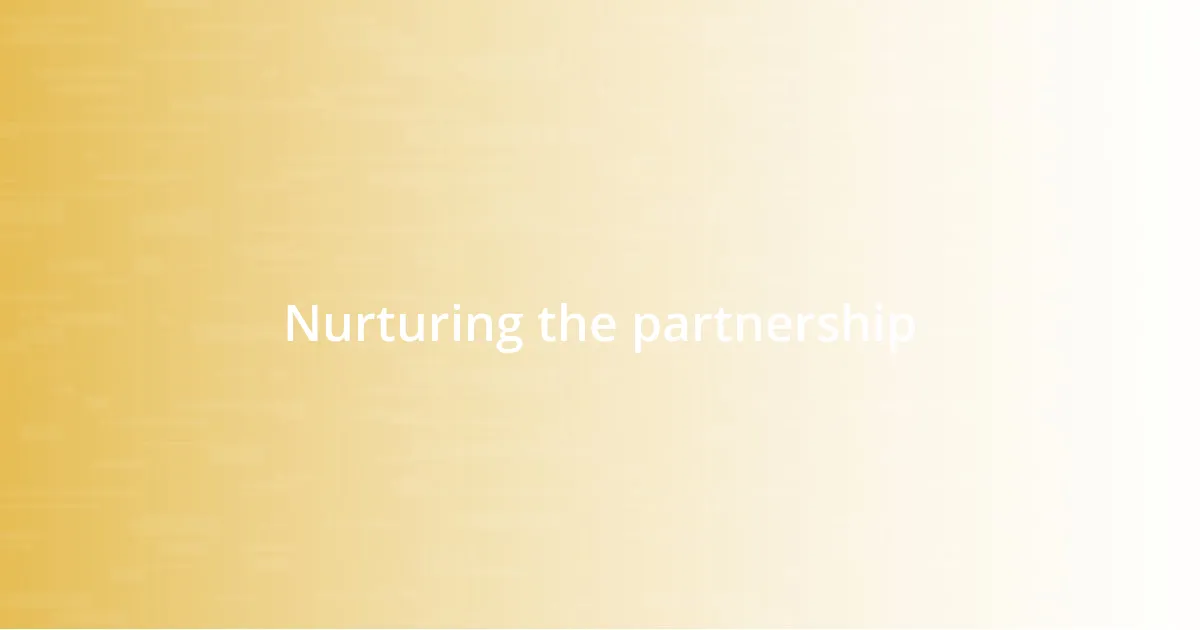
Nurturing the partnership
Nurturing a partnership is like tending to a garden; it requires patience and consistent effort. I recall a time when I made it a point to check in with a partner regularly, simply to ask how they were doing—not just about our projects. This small gesture deepened our connection, and it reminded me that genuine interest can foster stronger ties. Do you think a simple “how are you?” can create a ripple effect in a partnership?
Another key aspect is celebrating milestones together. I remember planning a small dinner to mark our first successful project completion. It was such an uplifting experience, allowing us to reflect on our journey and acknowledge each other’s contributions. Those moments of recognition not only create joy but also reinforce the bond of teamwork. Have you taken the time to celebrate achievements with your partners?
I’ve also learned that being mindful of giving space when needed is crucial. There was a period when a close partner needed time to refocus on their priorities. Instead of pushing for constant communication, I respected their needs, which ultimately brought us closer. It’s important to recognize when to step back; nurturing a partnership involves understanding when to lean in and when to give room to breathe. How do your partnerships grow when you allow for that breathing space?
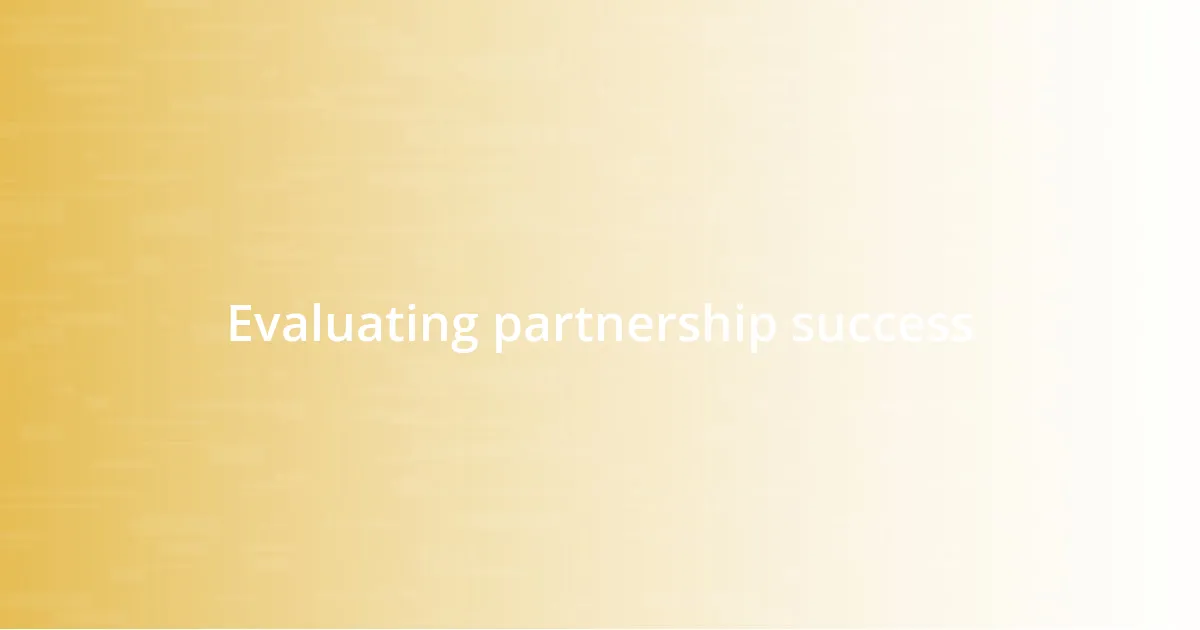
Evaluating partnership success
Evaluating the success of a partnership can feel like a daunting task, but I find it incredibly rewarding. For instance, I remember sitting down after a project was completed and reviewing not just the outcomes, but how we felt throughout the process. We listed our achievements, challenges, and personal growth. It was surprising to realize that the emotional journey often holds more value than the end results themselves. Have you taken the time to reflect on your partnerships in such a holistic way?
To me, the key indicators of success aren’t always tangible. I often gauge how well we communicate and resolve conflicts; those elements reveal the partnership’s true strength. I can recall a time when tensions arose during a project, but we tackled it head-on through honest dialogue. By the end, not only did we resolve the issue, but we also learned invaluable lessons about each other’s working styles. Isn’t it fascinating how struggles can sometimes lead to deeper connections?
I also advocate for regular check-ins to evaluate our partnership’s health. Setting aside time to discuss our expectations and aspirations can illuminate areas needing improvement. For example, I chose to implement quarterly reviews with a business partner, and it allowed us to recalibrate our goals together. It transformed our interactions from routine to meaningful. Have you considered how these conversations could enrich your partnerships?










